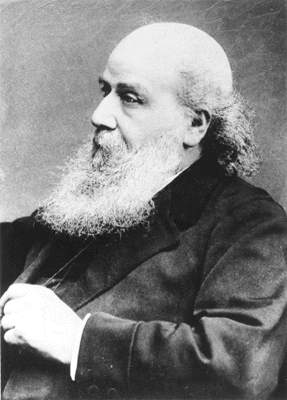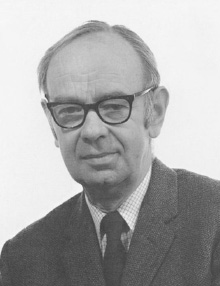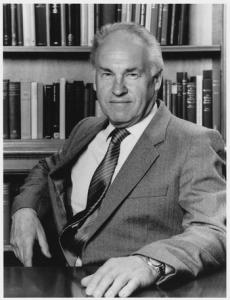
James Joseph Sylvester was an English mathematician. He made fundamental contributions to matrix theory, invariant theory, number theory, partition theory, and combinatorics. He played a leadership role in American mathematics in the later half of the 19th century as a professor at the Johns Hopkins University and as founder of the American Journal of Mathematics. At his death, he was a professor at Oxford University.

The Institute of Mathematics and its Applications (IMA) is the UK's chartered professional body for mathematicians and one of the UK's learned societies for mathematics.

Archibald "Archie" Howie is a British physicist and Emeritus Professor at the University of Cambridge, known for his pioneering work on the interpretation of transmission electron microscope images of crystals. Born in 1934, he attended Kirkcaldy High School and the University of Edinburgh. He received his PhD from the University of Cambridge, where he subsequently took up a permanent post. He has been a fellow of Churchill College since its foundation, and was President of its Senior Combination Room (SCR) until 2010.
Prof Arthur Geoffrey Walker FRS FRSE was a British mathematician who made important contributions to physics and physical cosmology. Although he was an accomplished geometer, he is best remembered today for two important contributions to general relativity.

Sir John Macleod Ball is a British mathematician and former Sedleian Professor of Natural Philosophy at the University of Oxford. He was the president of the International Mathematical Union from 2003 to 2006 and a Fellow of Queen's College, Oxford.
Eric Ronald Priest is Emeritus Professor at St Andrews University, where he previously held the Gregory Chair of Mathematics and a Bishop Wardlaw Professorship.

Alan Richard Bundy is a professor at the School of Informatics at the University of Edinburgh, known for his contributions to automated reasoning, especially to proof planning, the use of meta-level reasoning to guide proof search.

Christopher Michael Bishop is a British computer scientist. He is a Microsoft Technical Fellow and Director of Microsoft Research AI4Science. He is also Honorary Professor of Computer Science at the University of Edinburgh, and a Fellow of Darwin College, Cambridge. Chris was a founding member of the UK AI Council, and in 2019 he was appointed to the Prime Minister’s Council for Science and Technology.
Henry Keith Moffatt, FRS FRSE is a Scottish mathematician with research interests in the field of fluid dynamics, particularly magnetohydrodynamics and the theory of turbulence. He was Professor of Mathematical Physics at the University of Cambridge from 1980 to 2002.

Sir Kenneth "Ken" Murray FRS FRSE FRCPath was a British molecular biologist and the Biogen Professor of Molecular Biology at the University of Edinburgh.

Alan Robertson was an English population geneticist. Originally a chemist, he was recruited after the Second World War to work on animal genetics on behalf of the British government, and continued in this sphere until his retirement in 1985. He was a major influence in the widespread adoption of artificial insemination of cattle.
Herbert Harold Read FRS, FRSE, FGS, was a British geologist and Professor of Geology at Imperial College. From 1947-1948 he was president of the Geological Society.

The Marine Biological Association of the United Kingdom (MBA) is a learned society with a scientific laboratory that undertakes research in marine biology. The organisation was founded in 1884 and has been based in Plymouth since the Citadel Hill Laboratory was opened on 30 June 1888.
Timothy John Pedley is a British mathematician and a former G. I. Taylor Professor of Fluid Mechanics at the University of Cambridge. His principal research interest is the application of fluid mechanics to biology and medicine.

Philip Kumar Maini is a Northern Irish mathematician. Since 1998, he has been the Professor of Mathematical Biology at the University of Oxford and is the director of the Wolfson Centre for Mathematical Biology in the Mathematical Institute.

Douglas Jones MBE, FRS, FRSE was a mathematician known for his work in the field of electromagnetism.

James Henderson Naismith is Professor of Structural Biology at the University of Oxford, former Director of the Research Complex at Harwell and Director of the Rosalind Franklin Institute. He previously served as Bishop Wardlaw Professor of Chemical Biology at the University of St Andrews. He was a member of Council of the Royal Society (2021-2022). He is currently the Vice-Chair of Council of the European X-ray Free Electron Laser and Vice-President (non-clinical) of The Academy of Medical Sciences. It has been announced that he will be the Head of the MPLS division at Oxford in the autumn of 2023.

John Bryce McLeod, was a British mathematician, who worked on linear and nonlinear partial and ordinary differential equations.
Prof James Munro Dodd FRS FRSE FZS (1915–1986) was a British marine biologist. He was Emeritus Professor of Zoology at the University College of North Wales in Bangor. He was generally known as Jimmie Dodd. He specialised in Comparative Endocrinology within the field of zoology.
Peter Nicholas Pusey is a British physicist. He is an Emeritus Professor of Physics at the School of Physics and Astronomy of the University of Edinburgh.












